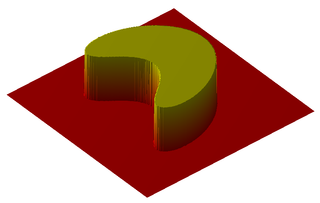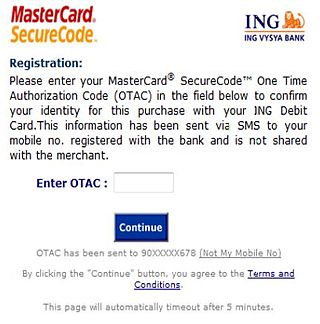DSSA/SPX
DSSA/SPX is the authentication protocol of DSSA. The CDC is a certificate granting server while the certificate is a ticket signed by CA which contains the public key of the party being certified. Since the CDC is merely distributing previously signed certificates, it is not necessary for it to be trusted.







In probability theory and statistics, the cumulative distribution function (CDF) of a real-valued random variable , or just distribution function of , evaluated at , is the probability that will take a value less than or equal to .
In mathematics, the determinant is a scalar value that is a function of the entries of a square matrix. The determinant of a matrix A is commonly denoted det(A), det A, or |A|. Its value characterizes some properties of the matrix and the linear map represented, on a given basis, by the matrix. In particular, the determinant is nonzero if and only if the matrix is invertible and the corresponding linear map is an isomorphism. The determinant of a product of matrices is the product of their determinants.
In number theory, a multiplicative function is an arithmetic function f(n) of a positive integer n with the property that f(1) = 1 and
In linear algebra, the trace of a square matrix A, denoted tr(A), is defined to be the sum of elements on the main diagonal of A. The trace is only defined for a square matrix.

A public key infrastructure (PKI) is a set of roles, policies, hardware, software and procedures needed to create, manage, distribute, use, store and revoke digital certificates and manage public-key encryption. The purpose of a PKI is to facilitate the secure electronic transfer of information for a range of network activities such as e-commerce, internet banking and confidential email. It is required for activities where simple passwords are an inadequate authentication method and more rigorous proof is required to confirm the identity of the parties involved in the communication and to validate the information being transferred.
In cryptography, a public key certificate, also known as a digital certificate or identity certificate, is an electronic document used to prove the validity of a public key. The certificate includes the public key and information about it, information about the identity of its owner, and the digital signature of an entity that has verified the certificate's contents. If the device examining the certificate trusts the issuer and finds the signature to be a valid signature of that issuer, then it can use the included public key to communicate securely with the certificate's subject. In email encryption, code signing, and e-signature systems, a certificate's subject is typically a person or organization. However, in Transport Layer Security (TLS) a certificate's subject is typically a computer or other device, though TLS certificates may identify organizations or individuals in addition to their core role in identifying devices. TLS, sometimes called by its older name Secure Sockets Layer (SSL), is notable for being a part of HTTPS, a protocol for securely browsing the web.

In mathematics, an indicator function or a characteristic function of a subset of a set is a function that maps elements of the subset to one, and all other elements to zero. That is, if A is a subset of some set X, then if and otherwise, where is a common notation for the indicator function. Other common notations are and
In cryptography, X.509 is an International Telecommunication Union (ITU) standard defining the format of public key certificates. X.509 certificates are used in many Internet protocols, including TLS/SSL, which is the basis for HTTPS, the secure protocol for browsing the web. They are also used in offline applications, like electronic signatures.

In mathematics, a Green's function is the impulse response of an inhomogeneous linear differential operator defined on a domain with specified initial conditions or boundary conditions.

The Needham–Schroeder protocol is one of the two key transport protocols intended for use over an insecure network, both proposed by Roger Needham and Michael Schroeder. These are:
The Wide-Mouth Frog protocol is a computer network authentication protocol designed for use on insecure networks. It allows individuals communicating over a network to prove their identity to each other while also preventing eavesdropping or replay attacks, and provides for detection of modification and the prevention of unauthorized reading. This can be proven using Degano.

A one-time password (OTP), also known as a one-time PIN, one-time authorization code (OTAC) or dynamic password, is a password that is valid for only one login session or transaction, on a computer system or other digital device. OTPs avoid several shortcomings that are associated with traditional (static) password-based authentication; a number of implementations also incorporate two-factor authentication by ensuring that the one-time password requires access to something a person has as well as something a person knows.
UNICORE (UNiform Interface to COmputing REsources) is a grid computing technology for resources such as supercomputers or cluster systems and information stored in databases. UNICORE was developed in two projects funded by the German ministry for education and research (BMBF). In European-funded projects UNICORE evolved to a middleware system used at several supercomputer centers. UNICORE served as a basis in other research projects. The UNICORE technology is open source under BSD licence and available at SourceForge.
Poly1305 is a universal hash family designed by Daniel J. Bernstein for use in cryptography.
Lambda lifting is a meta-process that restructures a computer program so that functions are defined independently of each other in a global scope. An individual "lift" transforms a local function into a global function. It is a two step process, consisting of;
Elliptic-curve Diffie–Hellman (ECDH) is a key agreement protocol that allows two parties, each having an elliptic-curve public–private key pair, to establish a shared secret over an insecure channel. This shared secret may be directly used as a key, or to derive another key. The key, or the derived key, can then be used to encrypt subsequent communications using a symmetric-key cipher. It is a variant of the Diffie–Hellman protocol using elliptic-curve cryptography.
In cryptography, Galois/Counter Mode (GCM) is a mode of operation for symmetric-key cryptographic block ciphers which is widely adopted for its performance. GCM throughput rates for state-of-the-art, high-speed communication channels can be achieved with inexpensive hardware resources.
In cryptography, implicit certificates are a variant of public key certificate. A subject's public key is reconstructed from the data in an implicit certificate, and is then said to be "implicitly" verified. Tampering with the certificate will result in the reconstructed public key being invalid, in the sense that it is infeasible to find the matching private key value, as would be required to make use of the tampered certificate.
Yahalom is an authentication and secure key-sharing protocol designed for use on an insecure network such as the Internet. Yahalom uses a trusted arbitrator to distribute a shared key between two people. This protocol can be considered as an improved version of Wide Mouth Frog protocol, but less secure than the Needham–Schroeder protocol.
The Neuman–Stubblebine protocol is a computer network authentication protocol designed for use on insecure networks. It allows individuals communicating over such a network to prove their identity to each other. This protocol utilizes time stamps, but does not depend on synchronized clocks.











